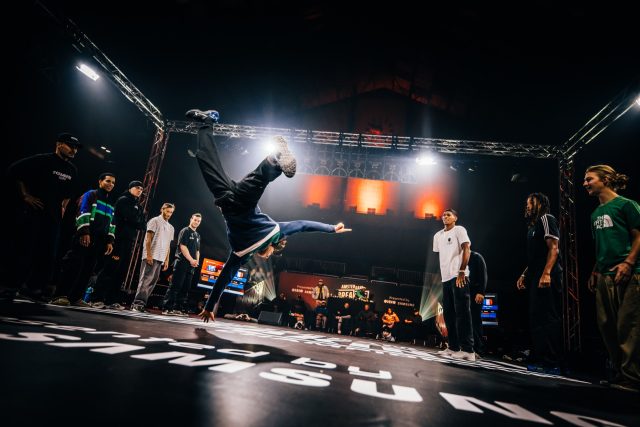
The capital is gearing up for the first Amsterdam Breaking Championships, presented by Odido and Samsung, on 9 December in the Centrale Markthal. Art, sports, music and dance come together in this cultural movement, which originated in the hip-hop scene. “It’s great to see the community get moving and what’s happening in Amsterdam right now “, says Paul van Dal, one of the enthusiastic initiators.
Paul van Dal was an early adopter of breaking in the Netherlands. He himself started breakdancing 23 years ago and ten years later started his own company, which focuses on media, communication, content and livestreams. “To bring breaking to the widest possible audience,” he says of the rationale behind it. “I organise many championships and with my own company New Dance TV, which has millions of followers online, we capture events all over the world.”
In addition, as founder of the Dutch Breaking League, he considers it his mission to make it possible for youth to enter in an accessible way. Van Dal is also technical director of Team NL Breaking, which will make its appearance at the Paris Olympics next year.
Formula 1
Van Dal also calls breaking the Formula 1 of dancing. “It goes super fast, it’s spectacular to see. You also notice when we show this online, that people are blown over, so to speak. Like: what is this? I had no idea this was possible with a human body. Unlike popping, locking, wacking, house dance or hip-hop freestyle. These are also dance styles with a culture attached, but breaking just looks more spectacular. As a result, you attract a much larger audience online as well,” experiences Van Dal.
“Breaking falls under the umbrella of hip-hop, which has four elements: deejaying, graffiti, MCs and breaking. And breaking again can be divided into four main elements. One is toprock, which is the standing dance where your musicality is super important because you do everything to the beat of the music. Then you have footwork, everything your hands and feet do on the floor, like quick steps. You have freezes, stationary movements, also to the beat of the music, and you have powermoves. That’s more the acrobatic bit.”
Olympic
Breaking has traditionally had a link to sports. Van Dal: “That competitiveness, battling against each other. Showing yourself against opponents, showing a jury that you have more to offer. With winners and losers, knock-out rounds, competitions, championships.”
The combination of all that intrigues. “That is present in other dance styles to a lesser extent. That’s why it feels logical now that it’s an Olympic sport, even though that’s only a small part of what breaking stands for.”
The community in the Netherlands has about 5,000 practitioners, according to Van Dal. “The spin-off that breaking gets from the Olympics will probably make it a bit bigger. And it certainly helps that we have a number of dancers in the Netherlands who are doing so well at the global level. Those are fantastic calling cards, showing what is possible if you really have ambitions and dreams as a dancer.”
Standards and values
Breaking also represents norms and values that Van Dal says many cultures could take an example from. “And also certain sports, because the mutual respect for each other is huge. It cuts across any background or culture and that’s great to see.”
Anyone attending a breaking event for the first time will definitely benefit from Van Dal’s tips and short guide. “A battle is quite difficult to understand properly. But it does help if you understand what the judges are looking at. So the moment you have a better understanding of what the judges are looking at, you will also understand better why, for example, someone spinning on his head and doing a somersault does not always win from someone doing footwork or toprock, which looks much less spectacular. The judges pay attention to details. Whoever shows that can win.”
Freestyle
In addition, the jury has an eye for much more. Van Dal: “The jury pays attention to a number of things and one of them is musicality. What many people don’t know is that when a battle starts, the dancers don’t know what kind of music they should dance to. The deejay decides that. Funk, hip-hop, disco or breakbeats, whatever. The dancer then tries to dissect that song and dance to it. So much of it is freestyle; on the accents of the song, they are going to show off their moves. The better you can freestyle and show musicality, the better that will be judged.
And then the judges also pay attention to your execution. So you can show a fantastic somersault, but if your landing is wrong, or you don’t continue properly in another movement or you show that you are not confident on the floor, that is also to your disadvantage. Conviction towards your opponent, towards the judges and the audience, those are important aspects.”
Own style
Finally, ‘foundation’ plays another role in judging. “That means the basics. You have a number of basic things and from there you try to distinguish yourself as a dancer through originality. For example, by giving those basic things just a touch of their own. This is very positively assessed, because it makes you unique. An own style and originality are super important.”
Repeating a trick is seen as a mortal sin. Van Dal: “Then you actually show that you don’t have enough in house to win. Copying is also a mortal sin; showing another dancer’s signature move, for example. And the jury has a good memory in that respect. They even remember a move by a dancer from Thailand from ten years ago.”
That is why one of the main slogans of breaking is “Each One, Teach One. Van Dal: “The things that have been and happened are important. You pass that on to the next generation.”



